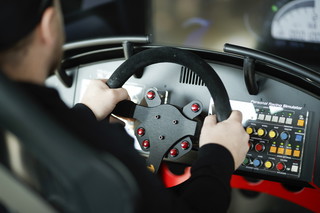
Getting into PC gaming can be hard, and getting into driving simulators, like iRacing, can be even harder. There are so many specs to know, and special equipment to acquire. It makes the head spin to put it all together. Well, we know that, and we are here to help clear the clutter. This is a quick guide to getting started in iRacing, consider it the easy button to going racing!
Starting from zero, you’re going to need a computer. For most, this is the hardest part about getting started. iRacing was designed to be easy on computers, and because of that most any modern computer has plenty of power to run the simulator. Even some laptops are plenty capable. The basic spec sheet runs like this:
- OS: Windows 7 64 bit or newer.
- RAM: 8 gb or greater.
- Graphics Card: Dedicated 2gb of memory or greater.
- Computer Memory: 10gb of free space, or greater.
Those are the basic minimums. Now, that looks a bit scary, but very likely the computer you are on right now meets or exceeds those requirements. Now, if you do not have a computer that was built recently, or want to have a dedicated system for your driving simulator, there are budget friendly, easy solutions there as well.
https://www.newegg.com/Product/Product.aspx?Item=9SIA77G5N88891
Now that you have a computer that will run iRacing, the next step is to get the driving hardware going. While iRacing does support hand-held controllers, like an Xbox controller, your driving experience is going to be tremendously improved by buying a wheel and pedals. There are lots of options to choose from, and you can spend as much as you’d like to on your setup. But, we are here for an 80%, easy button solution. Something close to this would be great equipment to get you started. Plenty capable, but still budget friendly:
Now that you have your hardware sorted, it needs a place to live. This is a preference heavy area of the simulator. There are no rulesets, specs, or even recommended setups to read about here. Lots of drivers find that clamping their wheel to their existing desk, and the pedal box under the desk works just fine. However, if that is not your style, and you want to keep the space dedicated, there are tons of simple setups out there, like this one. It's easy on the wallet, fairly compact, and does the job:
If you want something a little more official, and you don’t need it to store easily, this is a good option as well:
https://www.amazon.com/dp/B010W3O8R0/ref=sspa_dk_detail_0?pd_rd_i=B010W3O8R0&th=1
The internet is also full of “build it yourself” plans that start at “Free.99”.
With that, you are well on your way to having a fully functional driving simulator! All in all, if you are starting from scratch, you can get into being a race car driver for less than $1000, which isn’t a small chunk of change, especially when you think of it in terms of tires, coilovers, or even a fresh set of belts and a new bucket seat. But, put it in terms of unlimited practice, no maintenance bills, and no hours in the garage with greasy hands, and the price gets a whole lot better.





